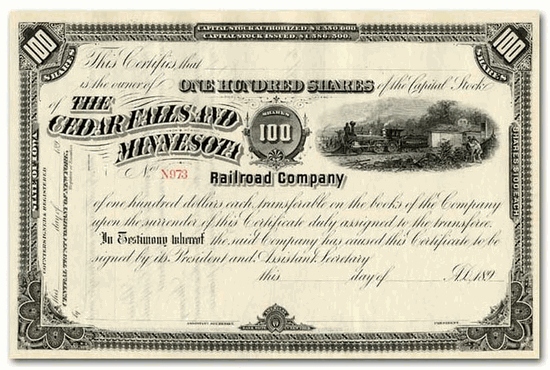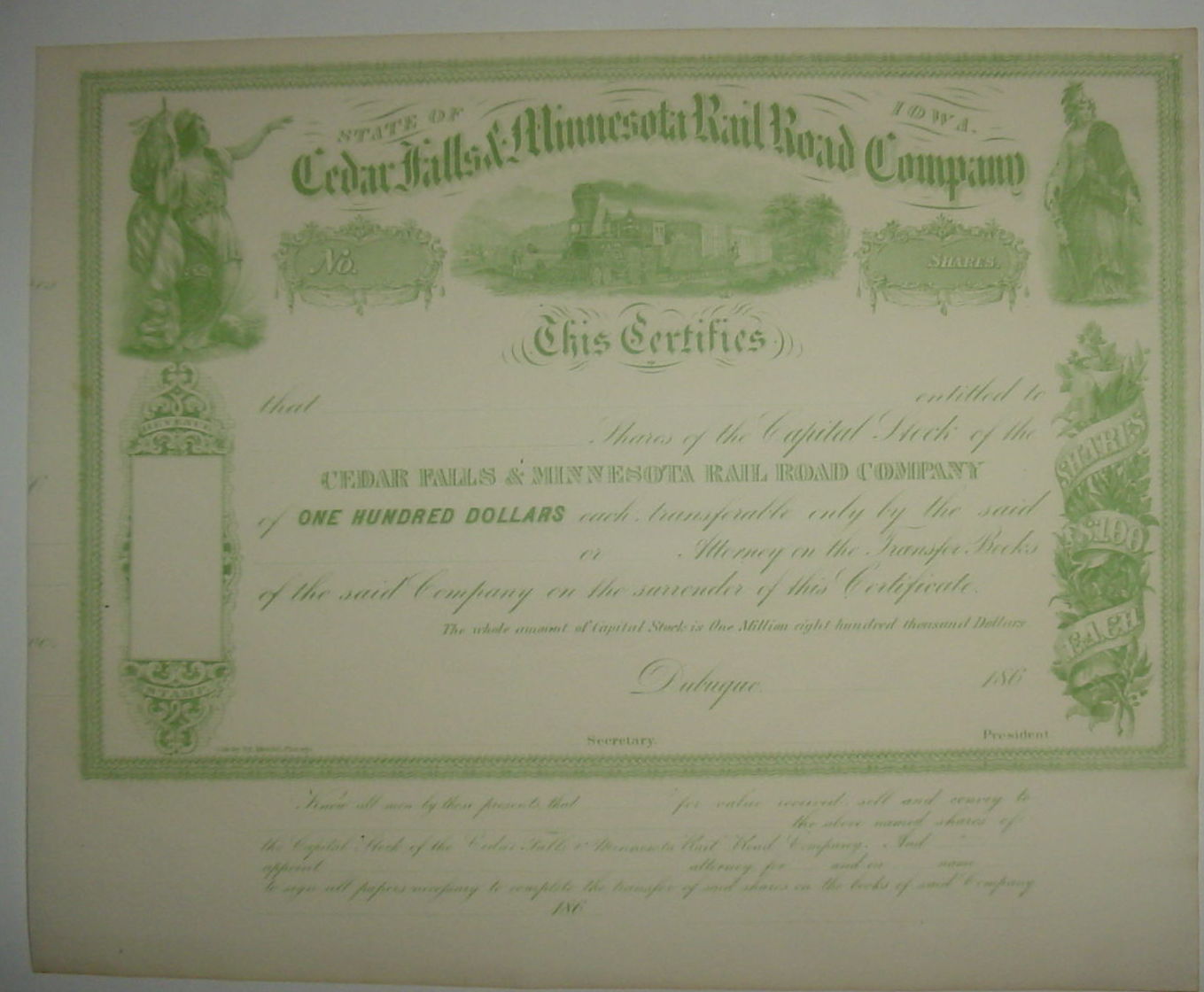Encyclopedia Dubuque
"Encyclopedia Dubuque is the online authority for all things Dubuque, written by the people who know the city best.”
Marshall Cohen—researcher and producer, CNN
Affiliated with the Local History Network of the State Historical Society of Iowa, and the Iowa Museum Association.
CEDAR FALLS AND MINNESOTA RAILROAD: Difference between revisions
No edit summary |
No edit summary |
||
| (6 intermediate revisions by the same user not shown) | |||
| Line 1: | Line 1: | ||
[[File:cfmm.gif|300px|thumb|left|]]CEDAR FALLS AND MINNESOTA RAILROAD. | [[File:cfmm.gif|300px|thumb|left|]] | ||
[[File:CFRR.jpg|300px|thumb|left|]]CEDAR FALLS AND MINNESOTA RAILROAD. The Cedar Falls and Minnesota Railroad was incorporated in on April 16, 1858 under the laws of Iowa and was controlled by [[SMITH, Platt|Platt SMITH]], Colonel R. B. Mason of the Illinois Central, and others associated with the [[DUBUQUE AND SIOUX CITY RAILROAD]]. (1) Its purpose was to construct a railroad from a point on the Dubuque and Sioux City Railroad through Waverly and Charles City to the Minnesota border. (2) There it was connected with the "Cedar Valley and Minneapolis" Road, (108 miles,) extending to St. Paul. The ground was so level that not a cut or filling of more than ten feet was required. (3) | |||
Work on the Cedar Falls to Waverly section was completed during the [[CIVIL WAR]]. (4) The first train left Waverly for Dubuque on March 13, 1865. Charles City was reached on October 18, 1868 and the Minnesota state line at Mona on May 1, 1870. (5) | |||
At a heated stockholders meeting begun in Dubuque on February 14, 1887, the Illinois Central was able to buy the Dubuque and Sioux City Railroad by paying $80.00 per share. This was the first battle between Edward H. Harriman of the Illinois Central and the famous banker, J. P. Morgan with Harriman the winner. (6) | |||
The 1868 ''Guide, Gazetteer and Directory of the Dubuque & Soux (sic) City Railroad'' stated that the office of this business was located at the corner of Locust and 5th. | |||
--- | --- | ||
| Line 11: | Line 13: | ||
Source: | Source: | ||
1. "New Railways in Iowa," ''The New York Times'', March 4, 1861, Online: http://www.nytimes.com/1861/03/04/news/new-railways-in-iowa.html | 1. "Iowa and the Illinois Central," '''Illinois Central Magazine''', November 1927, p. 5 | ||
2. Desty, Robert; Goodwin, James Wells Goodwin; Boyle, Peyton. '''The Federal Reporter'''. West Publishing Company, 1891, p. 485 | |||
3. "New Railways in Iowa," ''The New York Times'', March 4, 1861, Online: http://www.nytimes.com/1861/03/04/news/new-railways-in-iowa.html | |||
4. Stover, John F. '''History of the Illinois Central Railroad, ''' New York: Macmillan Publishing Company, Inc., 1975, p. 131 | |||
5. Donovan, Frank P. Jr. '''Iowa Railroads''' Iowa City: University of Iowa Press, 2000, p. 211 | |||
6. Donovan, p. 114 | |||
[[Category: Railroad]] | [[Category: Railroad]] | ||
Latest revision as of 16:02, 18 November 2016
CEDAR FALLS AND MINNESOTA RAILROAD. The Cedar Falls and Minnesota Railroad was incorporated in on April 16, 1858 under the laws of Iowa and was controlled by Platt SMITH, Colonel R. B. Mason of the Illinois Central, and others associated with the DUBUQUE AND SIOUX CITY RAILROAD. (1) Its purpose was to construct a railroad from a point on the Dubuque and Sioux City Railroad through Waverly and Charles City to the Minnesota border. (2) There it was connected with the "Cedar Valley and Minneapolis" Road, (108 miles,) extending to St. Paul. The ground was so level that not a cut or filling of more than ten feet was required. (3)
Work on the Cedar Falls to Waverly section was completed during the CIVIL WAR. (4) The first train left Waverly for Dubuque on March 13, 1865. Charles City was reached on October 18, 1868 and the Minnesota state line at Mona on May 1, 1870. (5)
At a heated stockholders meeting begun in Dubuque on February 14, 1887, the Illinois Central was able to buy the Dubuque and Sioux City Railroad by paying $80.00 per share. This was the first battle between Edward H. Harriman of the Illinois Central and the famous banker, J. P. Morgan with Harriman the winner. (6)
The 1868 Guide, Gazetteer and Directory of the Dubuque & Soux (sic) City Railroad stated that the office of this business was located at the corner of Locust and 5th.
---
Source:
1. "Iowa and the Illinois Central," Illinois Central Magazine, November 1927, p. 5
2. Desty, Robert; Goodwin, James Wells Goodwin; Boyle, Peyton. The Federal Reporter. West Publishing Company, 1891, p. 485
3. "New Railways in Iowa," The New York Times, March 4, 1861, Online: http://www.nytimes.com/1861/03/04/news/new-railways-in-iowa.html
4. Stover, John F. History of the Illinois Central Railroad, New York: Macmillan Publishing Company, Inc., 1975, p. 131
5. Donovan, Frank P. Jr. Iowa Railroads Iowa City: University of Iowa Press, 2000, p. 211
6. Donovan, p. 114



